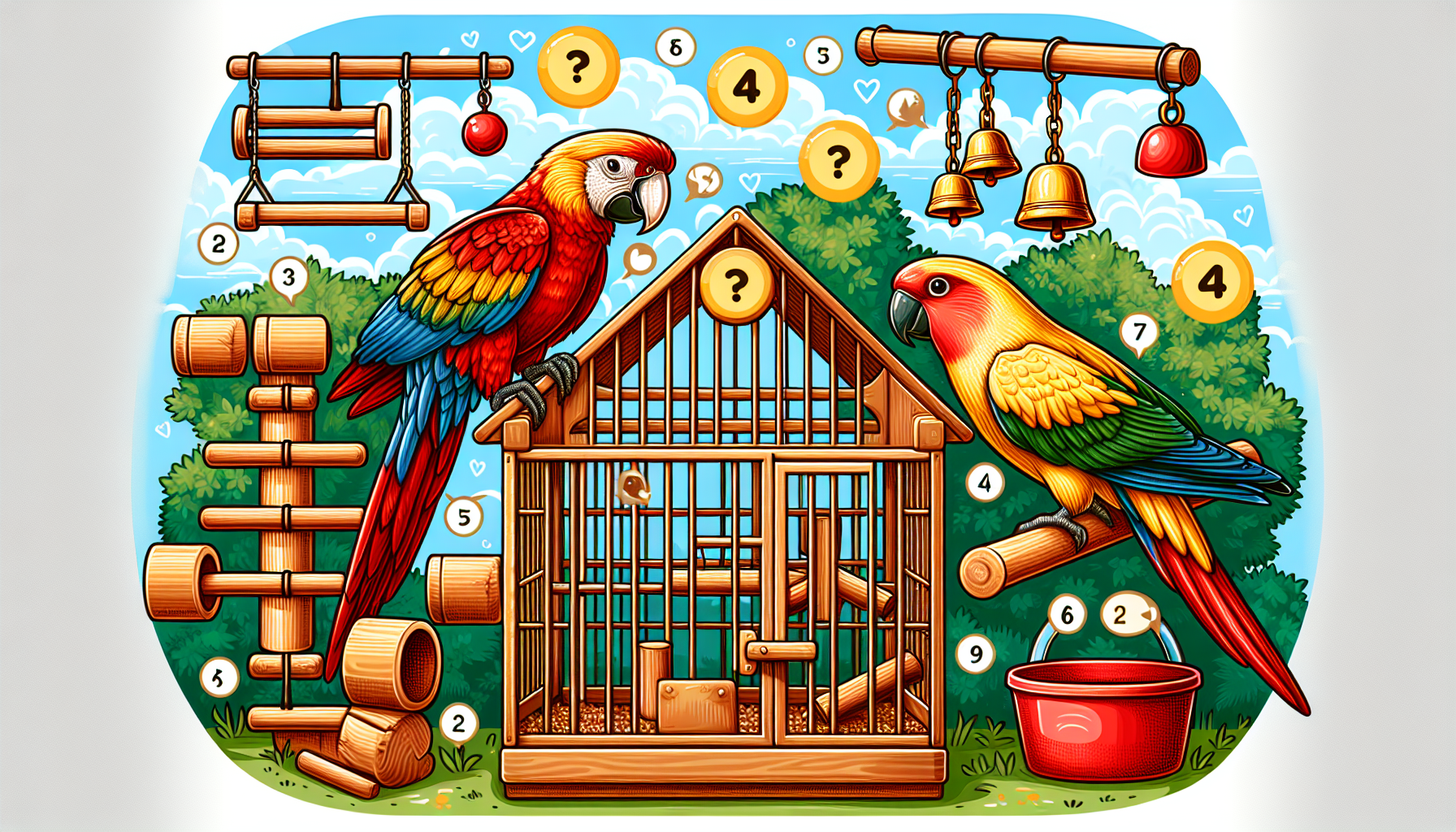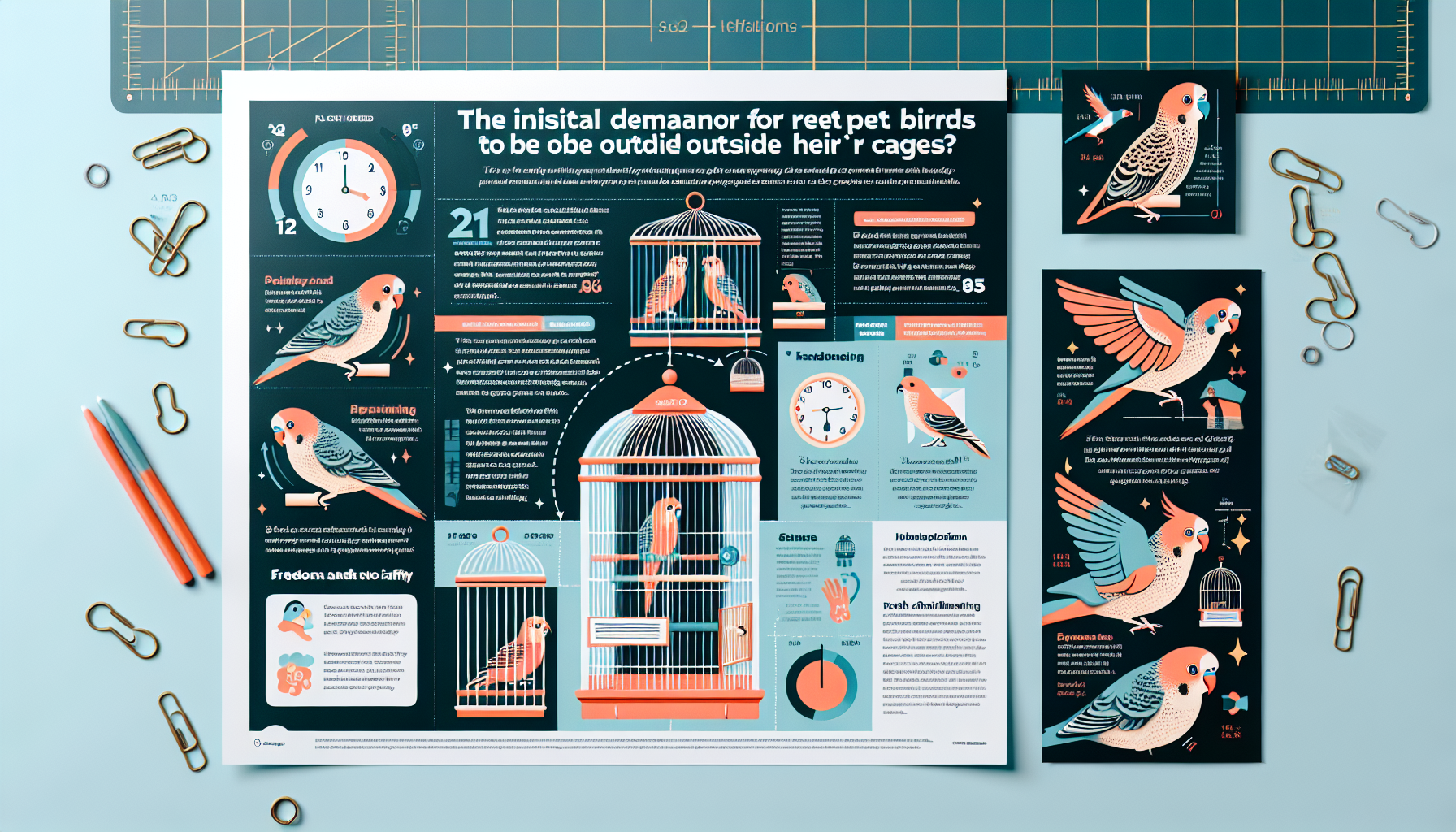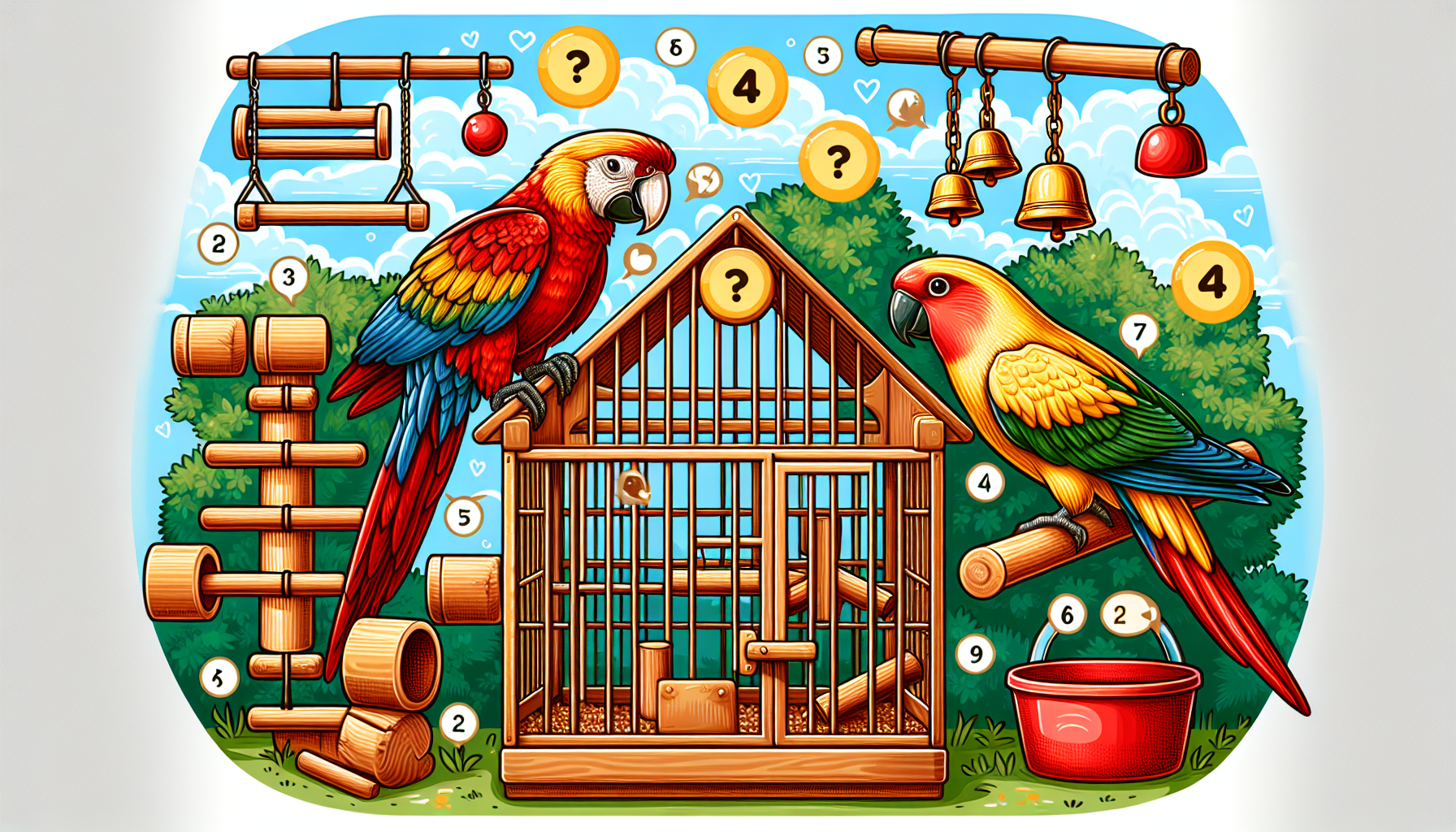Imagine the joy of having a pet bird chirping happily in your home, perched on your shoulder as you go about your day. But how long should your feathered friend actually be out of its cage? Balancing freedom and safety is crucial for your bird’s well-being, and finding the perfect amount of time can be a challenge. In this article, we will explore the factors to consider and provide some guidance on how long a pet bird should ideally spend outside its cage. So, get ready to create a harmonious environment for your avian companion!
As a general rule, your bird should receive 2 – 3 hours of out-of-cage activities each day. This is especially true for bigger birds such as the African Grey and Macaws. This rule should also be applied to all species of conures.

Determining the Appropriate Duration
Understanding the Breed and Individual Needs
When it comes to determining how long a pet bird should be out of its cage, it is essential to consider the breed and individual needs of the bird. Different bird species have different activity levels and social needs. For example, larger parrot species like African Greys and Macaws require more physical and mental stimulation compared to smaller bird species like finches or canaries.
Understanding the specific needs of your bird’s breed will help you determine the appropriate duration for their time out of the cage. Some birds may be content with shorter periods of freedom, while others may require longer durations to ensure their overall well-being. It’s important to research and learn about the breed characteristics to provide the best possible care for your feathered friend.
Considerations for Health and Safety
Ensuring a Bird-Friendly Environment
Before allowing your bird out of its cage, it is crucial to create a bird-friendly environment that minimizes potential hazards and dangers. Remove any toxic plants, chemicals, or objects that could be harmful to your bird. Ensure that windows and doors are securely closed to prevent accidental escapes. Creating a safe environment is essential to promote the bird’s well-being and overall safety during its time out of the cage.
Avoiding Hazards and Dangers
While being out of the cage provides freedom and stimulation for your bird, it’s important to be mindful of potential hazards and dangers in the surrounding area. Keep an eye out for open flames, hot surfaces, electrical cords, and other potential hazards that could harm your bird. It’s also important to prevent access to the kitchen and any other areas where the bird may encounter toxic substances or dangerous objects. Bird-proofing your home will help prevent accidents and ensure a safe environment for your feathered companion.
Establishing a Daily Routine
Scheduled Exercise and Playtime
Establishing a daily routine is crucial for your bird’s physical and mental well-being. Providing scheduled exercise and playtime is essential for maintaining their overall health. Plan specific times throughout the day when your bird can come out of its cage for exercise and play. This will not only provide necessary physical activity but also mental stimulation and social interaction.
Balancing Time Inside and Outside the Cage
While it is important to give your bird enough time out of its cage, it is equally important to strike a balance between freedom and cage time. Too much time outside the cage can lead to overstimulation and potential accidents, while too little time can result in boredom and stagnation. Find the right balance based on your bird’s breed, individual needs, and the availability of safe and engaging activities.

Factors Influencing Time Out of the Cage
Age of the Bird
The age of your bird plays a significant role in determining the appropriate duration for their time out of the cage. Younger birds may have more energy and require more frequent and extended periods of supervised freedom to burn off excess energy and explore their surroundings. Older birds, on the other hand, may not require as much physical activity and could be content with shorter outings.
Existing Health Conditions
If your bird has any existing health conditions, it is important to consult with a veterinarian to determine the appropriate duration for their time out of the cage. Some health conditions may limit their ability to engage in physical activity or require special precautions and supervision. Your veterinarian will provide guidance on how to accommodate your bird’s specific needs and ensure their safety and well-being.
Cage Size and Comfort
The size and comfort of your bird’s cage also play a role in determining the duration of their time out. Birds with larger cages that offer ample space for exercise and enrichment may require shorter periods of freedom compared to birds in smaller cages. If your bird’s cage is smaller, it is essential to compensate with longer periods of supervised freedom to ensure they have enough room to stretch their wings and engage in natural behaviors.
Socialization and Interaction
Birds are social creatures and thrive on social interaction. If your bird has the opportunity to interact with you and other members of the household during their time out of the cage, it can contribute to their overall well-being. Chirping, talking, and spending quality time with your bird can help fulfill their social needs. However, if your bird lacks socialization opportunities, it may require longer periods of freedom to compensate for the lack of social interaction.
Supervising the Bird During Free Time
Keeping an Eye on the Bird
During their time out of the cage, it is crucial to keep a close eye on your bird to ensure their safety and well-being. Birds are curious creatures and may explore areas that could potentially be dangerous. By closely supervising your bird, you can quickly intervene and prevent accidents or escapes. It’s important to be present and attentive during this time to provide guidance and support to your feathered friend. You will also want to keep an eye on younger children around your bird. Kids are very curious by nature and can unintentionally cause harm to your bird.
Preventing Accidents and Escapes
Accidents and escapes can happen even in the safest of environments. To minimize the risk, ensure that windows and doors are securely closed and that there are no openings or gaps where your bird could squeeze through. Keep an eye on potential hazards such as open flames, hot surfaces, or objects that could potentially harm your bird. Taking proactive measures to prevent accidents and escapes will help keep your bird safe during their time out of the cage.
Importance of Bird-Proofing
Bird-proofing your home is an essential step in ensuring a safe environment for your bird’s free time. Covering or securing electrical cords, removing toxic plants, and securing small objects that could be swallowed are all important bird-proofing measures. It’s important to create a space where your bird can explore and play without the risk of encountering harmful substances or objects. By bird-proofing your home, you can minimize potential dangers and promote a safe environment for your feathered companion.
Making Use of Play Gyms and Stands
Benefits of Play Gyms
Play gyms provide a dedicated space for your bird to engage in exercise and play while outside the cage. They typically feature various perches, ladders, toys, and interactive elements that can keep your bird entertained and mentally stimulated. By providing a play gym, you offer your bird a designated area where they can stretch their wings, climb, and explore in a safe and controlled manner.
Choosing the Right Stand
When selecting a stand for your bird, it is important to consider its size and design. The stand should be sturdy and stable to prevent any accidents or tip-overs. Ensure that the stand is appropriately sized for your bird, allowing enough space for them to move around comfortably. Additionally, consider the materials used in the stand to ensure they are safe and non-toxic for your bird. The right stand can provide an ideal space for your bird’s out-of-cage time, enhancing their overall well-being and enjoyment.
Training and Taming Sessions
Implementing Regular Training Sessions
Training sessions can be an excellent way to bond with your bird and establish a strong relationship based on trust and positive reinforcement. Incorporate regular training sessions into your bird’s daily routine, where you can teach them basic commands, tricks, or engaging activities. These sessions not only provide mental stimulation but also allow your bird to learn and develop skills while spending time outside the cage.
Promoting Taming and Bonding
Taming and bonding with your bird is an ongoing process that requires patience and consistency. During their time out of the cage, take the opportunity to interact with your bird in a gentle and positive manner. Offer treats, engage in gentle petting, and talk to your bird in a soothing tone. Gradually build trust and confidence, allowing your bird to feel comfortable and secure in your presence. By promoting taming and bonding, you create a nurturing environment that supports your bird’s emotional well-being.
Providing Mental and Physical Stimulation
Toys, Puzzles, and Foraging Activities
Birds are intelligent creatures that require mental stimulation to stay happy and healthy. Provide a variety of toys, puzzles, and foraging activities both inside and outside the cage. Interactive toys, puzzle feeders, and foraging opportunities can keep your bird engaged and mentally stimulated during their time out of the cage. Rotate the toys regularly to maintain novelty and prevent boredom.
Rotating Cage Accessories and Perches
To prevent boredom and encourage physical exercise, regularly rotate the accessories and perches within your bird’s cage. This will provide a fresh environment, stimulating your bird’s curiosity and natural instincts. Different types of perches, such as wooden branches or rope perches, can also help promote foot health and muscle stimulation. By regularly changing the cage setup, you can keep your bird mentally and physically active.
Recognizing Signs of Stress or Boredom
Observing Behavioral Cues
As a responsible bird owner, it is important to observe your bird’s behavior for any signs of stress or boredom. Birds communicate through their body language and vocalizations. Look for signs such as excessive screaming, feather plucking, restlessness, aggression, or withdrawal. These behaviors may indicate that your bird is not receiving enough mental or physical stimulation during their time out of the cage. By paying attention to their subtle cues, you can make adjustments to ensure their well-being.
Understanding Stress Triggers
Every bird is different, and certain situations or stimuli may trigger stress in your individual bird. Pay attention to the triggers that seem to cause stress or discomfort for your feathered friend. This could include loud noises, sudden movements, or unfamiliar visitors. Once you identify these triggers, you can take steps to minimize or avoid them during your bird’s out-of-cage time. Creating a stress-free environment will contribute to your bird’s overall happiness and well-being.
Implementing Adjustments
If you notice signs of stress or boredom in your bird, it is important to make adjustments to their out-of-cage routine. Increase the duration of their time outside the cage, provide additional mental stimulation through interactive toys or puzzles, and engage in more quality interaction and socialization. By understanding your bird’s individual needs and making necessary adjustments, you can ensure that they are happy, healthy, and thoroughly enjoying their time outside the cage.
Balancing Freedom and Safety
Finding the Right Balance
Finding the right balance between freedom and safety is crucial when determining the appropriate duration for your bird’s time out of the cage. It’s important to provide enough freedom to meet their physical and mental needs while also prioritizing their safety. Monitor your bird’s behavior and energy levels to gauge whether they are receiving an appropriate amount of time outside the cage. Remember, each bird is unique, so finding the right balance may require some trial and error.
Gradual Increase in Out-of-Cage Time
If your bird is not accustomed to spending time outside the cage, it is best to gradually increase the duration over time. Start with short periods and gradually extend them as your bird becomes more comfortable and adjusted to their surroundings. This gradual approach allows your bird to acclimate to the new environment and reduces the risk of overwhelming or stressful situations. By taking it slow, you can ensure a positive and enjoyable experience for your feathered companion.
In conclusion, determining the appropriate duration for a pet bird’s time out of its cage requires careful consideration of various factors such as breed, individual needs, health conditions, cage size, and socialization opportunities. By creating a bird-friendly environment, establishing a daily routine, and providing mental and physical stimulation, you can enhance your bird’s overall well-being. By closely supervising your bird, preventing accidents, and bird-proofing your home, you can ensure their safety during their free time. Remember to pay attention to your bird’s behavioral cues, make adjustments as needed, and find the right balance between freedom and safety. With proper care and attention, your feathered friend can enjoy a fulfilling and enriching life outside their cage.

My name is Shane Warren, the author behind Your Bird Buddy – your ultimate guide to the wonderful world of birds! Unleash your inner avian explorer as we delve into a vibrant library of knowledge dedicated to all things feathered. From learning about diverse bird species from across the globe to understanding their captivating habitats and behaviors, I’m here to fuel your passion for these magnificent creatures. Not only that, but I also provide valuable insights on being a responsible and informed pet bird owner. Join our vibrant community and let’s celebrate the feathered wonders of the world together – one chirp at a time. And be sure to join our Your Bird Buddy Community over on Facebook!


Comments are closed